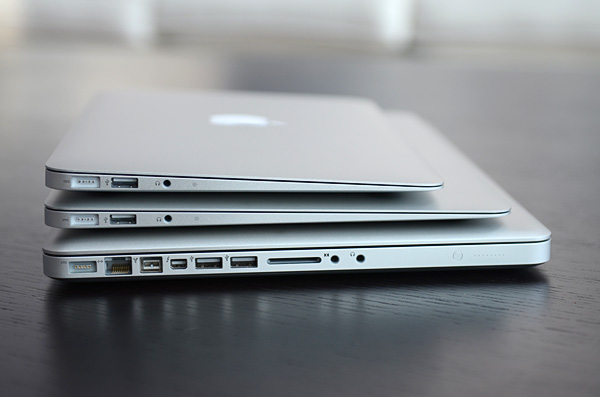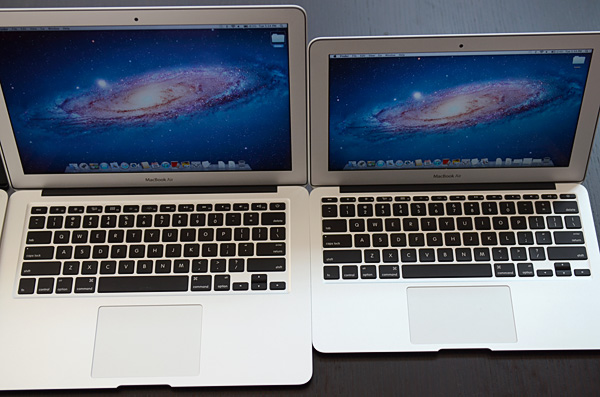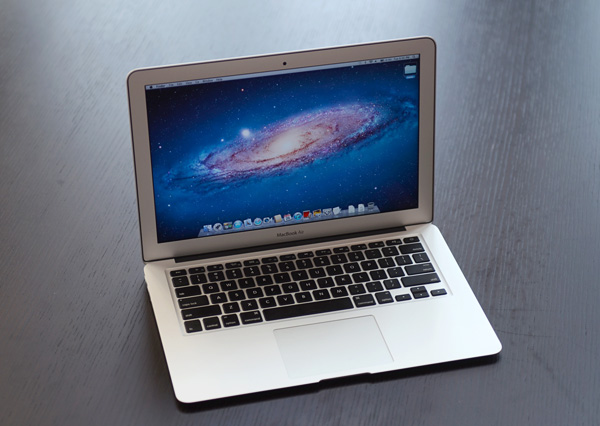The 2011 MacBook Air (11 & 13-inch): Thoroughly Reviewed
by Anand Lal Shimpi on July 28, 2011 3:25 AM EST- Posted in
- Apple
- Mac
- Intel
- Sandy Bridge
- MacBook Air
- Laptops
The 11
The 11-inch MacBook Air comes with a 1366 x 768 display (16:9) measuring 11.6-inches along the diagonal. Ports and features are near identical to last year's model. Up top there's a 640 x 480 camera. Along each side is a USB 2.0 port. Mag Safe and headphone jack are on the left, while Thunderbolt is on the right. There's a single fan inside the chassis that vents between the keyboard and the display hinge.
The 11 is still an amazing form factor. It's painless to carry around and you end up with a tablet sized device that makes no functional sacrifices. To make things even better, now you get a full blown Sandy Bridge CPU inside the ultra slim chassis.
There are really only two things that the 11-inch MacBook Air lacks. For starters, the lack of an integrated SD card reader means anyone looking to do photo work on the go will either need an Eye-Fi or an external USB card reader. Neither is too much of a pain however an integrated reader would be much appreciated.
The second issue with the 11 is its screen size/resolution. At 1366 x 768 you get great pixel pitch on the 11-inch 16:9 screen but there's just not a lot of vertical resolution on the display. The 13-inch model gives you only 5% more horizontal resolution but 17% more vertical, and that's noticeable.
Lion does alleviate some of this problem thanks to its full screen mode. Viewing Mail or Safari in full screen is almost necessary on the 11. Thanks to the 16:9 ratio of the panel, watching movies on the 11 is nearly equivalent to watching them on the 13-inch Air.
The base $999 configuration only comes with 2GB of DDR3 and a 64GB SSD. The latter is excusable if you just don't do much with your system (and technically it's something you can upgrade down the line if you'd like) but the former is a major problem. Memory on the MacBook Air is soldered directly onto the motherboard. Not having to build in a socket helps keep the z-height of the system down to a minimum, but it also severely limits flexibility. For most users interested in a dual-core machine under OS X I'd say that 4GB is probably good enough. While I'd prefer the option of upgrading to 8GB, I think 4GB is livable; 2GB is not. If you're considering the entry-level 11-inch MacBook Air I'd strongly recommend at least upgrading the memory to 4GB. The only exception is if you're just going to spend your time doing very basic tasks on the machine and plan on upgrading again in a year or two. If that's the case save your money and enjoy a 4GB version with Ivy Bridge next year. For everyone else, make sure you get the memory upgrade.
The 13
While the 11 is almost tablet-like, the 13-inch MacBook Air still looks and feels like a normal notebook. A really thin, really light notebook. You get a 1440 x 900 (16:10) display that measures 13.3-inches along the diagonal. The port layout is identical to the 11 although you get an integrated SD card reader along the right of the machine.

From top to bottom: 11-inch MacBook Air, 13-inch MacBook Air, 15-inch MacBook Pro
The 13 is really a pleasure to use, despite feeling a lot like a traditional notebook. The biggest difference for me between it and the 11 is the height of the display. Seated on a couch with the notebook in my lap the 13 doesn't force me to look down as much to see the screen. I still have to tilt my head down a bit, just not as much as with the 11.
The 13-inch screen maintains a relatively high pixel density, just shy of the 128 pixels per inch you get from the 15-inch MacBook Pro with the upgraded 1680 x 1050 display. I find the 13 is a bit easier to look at than the 11 with its 135 PPI display, but that's a personal preference. Apple really needs to increase the resolution of its 13-inch MacBook Pro which is a paltry 1280 x 800.

13-inch MacBook Air (left) vs. 11-inch MacBook Air (right)
The 13's base configuration is actually really good. You get 4GB of memory (neither Air supports more than 4GB of RAM) and a 1.7GHz Core i5. The 1.7GHz part here is a bit more interesting than the 1.6GHz chip in the 11 because it supports much higher max turbo frequencies (2.4/2.7GHz vs. 2.0/2.4GHz). If you don't need more than 128GB of internal storage, my recommendation would be to go for the base 13 at $1299.











103 Comments
View All Comments
tipoo - Thursday, July 28, 2011 - link
I'd like to know too, in fact I think a decibel reading for laptop reviews would be great.solatic - Thursday, July 28, 2011 - link
"... [It's] easy to imagine a future where laptops become a lot more like the new Air and shift to a couple high bandwidth ports instead of numerous lower bandwidth connections."I agree in a sense, but I very much disagree with the manner of your idea.
Getting rid of low-bandwidth ports on laptops is stupid because these low-bandwidth ports are industry standards. The standard display jack for projectors everywhere, from business rooms to classrooms etc., is VGA. Good old VGA from the 90's which was never displaced by HDMI or DVI despite their ubiquity and technological superiority. Why is irrelevant, but my point is that I can't tell you how many people I've seen with Apple laptops who time and again have asked to borrow my machine with its VGA port because they can't find their VGA dongle or forgot it at home/the office.
VGA, RJ-45, USB - we don't use these jacks because of how much bandwidth they move but because we know we will encounter devices in the field that will use them.
What you really want, Anand, is a docking station. Lenovo/IBM has/did made/make them for some time for the Thinkpad line. You come to the office, slide your laptop in, and boom - the docking connector is a high bandwidth connector that connects you to network, display, audio, interface, etc.
The only real problem with docking stations is that they're either proprietary (the Thinkpad ones) or they're too slow for higher-bandwidth applications (USB docking stations). If you see a future in Thunderbolt docking station-type devices - like the Thunderbolt display - then this is a good thing. The Thunderbolt display can now be used by any Apple computer with a Thunderbolt port - whereas Lenovo has to manufacture different docking stations for the X and T series and these docking stations can't be used with Toshibas, Apples, Dells, etc.
But to propose getting rid of VGA and RJ-45 ports now is not something I can agree with. Put Thunderbolt on new machines, make Thunderbolt projectors etc., wait for them to saturate the market - and then, only then, does it really make sense to get rid of these slower ports.
repoman27 - Friday, July 29, 2011 - link
It certainly makes sense to ditch VGA on a product like the MacBook Air, since a VGA port is too large to physically fit inside it. And it makes sense on all other laptops since most people would rather have 10 more mins of battery life all the time than a VGA port on the odd occasion that they need one. I propose that those who own archaic video devices lacking a digital interface buy a $5 adapter and leave it attached to the device, that way people with modern notebooks can connect to them without issue.The lack of a wired Ethernet port on the Airs is also due to its ultra slim profile, but it amazes me how many people I know that have no idea that they can plug their laptops into a wired network and get far better throughput. As long as WiFi offers more bandwidth than most people's ISPs, I think you can kiss that RJ45 port goodbye without upsetting too many folks.
Wolfpup - Thursday, July 28, 2011 - link
Great reviews like this are why I love this site. Super thorough and interesting on the tech, and, interesting thoughts on practical stuff too.I prefer Windows, but have been wanting a secondary Mac for a while for the heck of it. I'm SUPER torn on what to get...
The 11.6" almost seems perfect, since I can throw it in my bag with my main notebook and be okay-stick it on my desk without too much issue. But...if I ever actually used it as my primary system, the 13.3" one would be a lot more usable. And at THAT point, the 13.3" Pro is a lot more usable, and at THAT point, the 15.4" Pro isn't much larger, and completely destroys it, and of course could be my main system...
Sooooo you see my dilemma ;)
Heh...maybe I should just go with the 11 since I'm not planning on using it as my primary.
name99 - Thursday, July 28, 2011 - link
"All three parts support Hyper Threading and Quick Sync, although the latter remains mostly unused in OS X. "Quick Sync is used by iChat HD, is it not?
The other natural client for it would be AirPlay. My guess is that, come iOS5 in September, we will see AirPlay on SNB macs beefed up to be able to stream any content (not just h264) to AirPlay devices by doing the transcode transparently on Quick Sync.
The third obvious sort of client would be a library that third party apps like HandBrake would get to. What's the currents situation now --- do you need to be root to get to QuickSync or can any app use it?
My guess is that we are facing the constant problem of new "weird" hardware --- it never comes virtualizable in the first iteration, which means that there is ALWAYS the problem of how to mediate access. And we generally see the same pattern
(a) A single app that is allowed access.
(b) Some sort of library that provides its own mechanisms for mediating access.
(c) The hardware (FINALLY) becomes virtualizable.
Apple is currently at step (a). Getting to (b) is never completely trivial (in spite of the claims of no-nothings in blog comments), at least if you want to do the job properly. You have to consider questions like --- do you use a reservation model, or do you simply provide notifications when you want to grab the hardware away from a user? How easy is it juggle state and provide something that looks virtualized? etc etc.
And there are ALWAYS, at least in the first gen, weird hardware interlocks that make life more difficult. I know nothing about QuickSync but I would not be surprised if, for example, using it has implications for using the main GPU, meaning one more thing that has to be balanced in the attempt to make it used more generally.
Can someone from the Windows world (who understands these issues, and has something more useful to say than "Macs suck") tell us how QuickSync is used in the MS world? Does MS provide a general purpose library, and how does the mediation model for that library work?
name99 - Thursday, July 28, 2011 - link
Oops, my bad. The Macbook Airs apparently do not have an HD camera because it can't fit in the available depth of the thin screen. So no iChat HD on these models.I think the rest of what I said, especially about AirPlay, still stands.
rootheday - Friday, July 29, 2011 - link
The sharing/scheduling of the GPU enginers by multiple client applications on Windows is mediated by the OS as part of the WDDM driver model dating back to Windows Vista - QuickSync is no exception. This means that we are already at c) on your hierarchy on Windows with multiple client applications able to easily share the GPU for encoding.Moreover, Intel has a library already for this - see http://software.intel.com/en-us/articles/media/
The media sdk library provides an API that applications can use to perform encoding and decoding. If run on a system with QuickSync hardware support and drivers, the work is routed to the GPU. If not, the library offers a CPU fall back path. This allows ISVs to write their application once - it will just run faster on Sandybridge systems.
I don't know enough about Apple OS and graphics driver model to comment on how hard it would be for Apple to get to the same level.
jvmxtra - Thursday, July 28, 2011 - link
Thanks for the great review. I throughly enjoyed your review but I feel like one thing is missing.In fact, for a laptop review, I really want all the sites to start devoting some time and even creating a method to measure the heat that laptop brings on. We have to create some type of way to measure(benchmark?) the heat index as I feel like how hot laptop gets under certain circumstance is critical factor.
In fact, I had to trade in my 15 inch mbp since it was just getting too hot.
tipoo - Thursday, July 28, 2011 - link
The thermals and power consumption page is a start.name99 - Thursday, July 28, 2011 - link
"This is what Thunderbolt was meant to do. All we need now is widespread adoption, more accessories and a standard for external GPU form factors."AND device manufacturers who are not idiots. In particular, where are the TB hubs?
The device the market obviously wants is a TB to USB3 hub ---
two TB ports, four USB3 ports --- and yet we still have not seen this.
I'm sorry, Sonnet, but this would be VASTLY more useful than your EN and FW800 bridges.
WTF is going on?